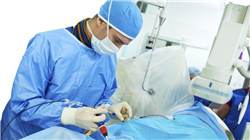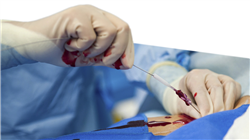University certificate
The world's largest faculty of medicine”
Introduction to the Program
With this Postgraduate diploma, 100% online, you will master the most sophisticated Arterial Interventional Techniques and perform interventions of the highest level”

The treatment of complex arterial lesions presents a series of challenges for healthcare professionals, requiring not only technical precision, but also a comprehensive understanding of the therapeutic options available. Given the constant advance of procedures in this area, the result of research conducted by the scientific community, physicians need to renew their knowledge on a regular basis in order to enrich their clinical practice with the most innovative treatment methods. However, in the academic panorama there is a lack of pedagogical programs that combine these advances with precision and that have a practical focus that adjusts to the requirements of today's labor market.
For this reason, TECH has developed a unique and comprehensive program in Arterial Interventional Procedures. The syllabus will examine the latest developments in this field, from advanced catheterization techniques to therapies based on local drug release. Likewise, the syllabus will delve into imaging procedures for both the diagnosis and follow-up of Vascular Diseases. This will allow physicians to perform more precise evaluations to detect possible pathologies. In relation to this, the didactic materials will emphasize the various applications of the integration of Artificial Intelligence in Endovascular Procedures, among which the increase in the efficiency of surgical procedures stands out.
This program is delivered through a 100% online modality, making it easy for practitioners to plan their own study schedules to experience a fully efficient update. In addition, specialists will enjoy a wide variety of multimedia resources designed to promote dynamic and natural teaching. To access the Virtual Campus, all professionals will need is a device with Internet access (including their own cell phone). They will also be supported at all times by an experienced teaching staff, who will resolve all the doubts that may arise during their academic itinerary.
Address the most cutting-edge Stroke Therapies at the world's best digital university according to Forbes”
This Postgraduate diploma in Arterial Interventional Procedures contains the most complete and up-to-date scientific program on the market. The most important features include:
- The development of case studies presented by experts in Angiology and Vascular Surgery
- The graphic, schematic and practical contents with which it is conceived gather scientific and practical information on those disciplines that are essential for professional practice
- Practical exercises where self-assessment can be used to improve learning
- Its special emphasis on innovative methodologies
- Theoretical lessons, questions to the expert, debate forums on controversial topics, and individual reflection assignments
- Content that is accessible from any fixed or portable device with an Internet connection
You will delve into the applications of Artificial Intelligence in vascular image analysis and employ it to plan surgical procedures”
The program’s teaching staff includes professionals from the sector who contribute their work experience to this specializing program, as well as renowned specialists from leading societies and prestigious universities.
The multimedia content, developed with the latest educational technology, will provide the professional with situated and contextual learning, i.e., a simulated environment that will provide immersive education programmed to learn in real situations.
This program is designed around Problem-Based Learning, whereby the professional must try to solve the different professional practice situations that arise during the course. For this purpose, students will be assisted by an innovative interactive video system created by renowned and experienced experts.
You will master the Angioplasty and Stenting Techniques in the Superficial Femoral Artery in only 6 months"

Thanks to TECH's disruptive Relearning method, you will assimilate the essential concepts in a fast, natural and precise way"
Why study at TECH?
TECH is the world’s largest online university. With an impressive catalog of more than 14,000 university programs available in 11 languages, it is positioned as a leader in employability, with a 99% job placement rate. In addition, it relies on an enormous faculty of more than 6,000 professors of the highest international renown.

Study at the world's largest online university and guarantee your professional success. The future starts at TECH”
The world’s best online university according to FORBES
The prestigious Forbes magazine, specialized in business and finance, has highlighted TECH as “the world's best online university” This is what they have recently stated in an article in their digital edition in which they echo the success story of this institution, “thanks to the academic offer it provides, the selection of its teaching staff, and an innovative learning method aimed at educating the professionals of the future”
A revolutionary study method, a cutting-edge faculty and a practical focus: the key to TECH's success.
The most complete study plans on the university scene
TECH offers the most complete study plans on the university scene, with syllabuses that cover fundamental concepts and, at the same time, the main scientific advances in their specific scientific areas. In addition, these programs are continuously being updated to guarantee students the academic vanguard and the most in-demand professional skills. In this way, the university's qualifications provide its graduates with a significant advantage to propel their careers to success.
TECH offers the most comprehensive and intensive study plans on the current university scene.
A world-class teaching staff
TECH's teaching staff is made up of more than 6,000 professors with the highest international recognition. Professors, researchers and top executives of multinational companies, including Isaiah Covington, performance coach of the Boston Celtics; Magda Romanska, principal investigator at Harvard MetaLAB; Ignacio Wistumba, chairman of the department of translational molecular pathology at MD Anderson Cancer Center; and D.W. Pine, creative director of TIME magazine, among others.
Internationally renowned experts, specialized in different branches of Health, Technology, Communication and Business, form part of the TECH faculty.
A unique learning method
TECH is the first university to use Relearning in all its programs. It is the best online learning methodology, accredited with international teaching quality certifications, provided by prestigious educational agencies. In addition, this disruptive educational model is complemented with the “Case Method”, thereby setting up a unique online teaching strategy. Innovative teaching resources are also implemented, including detailed videos, infographics and interactive summaries.
TECH combines Relearning and the Case Method in all its university programs to guarantee excellent theoretical and practical learning, studying whenever and wherever you want.
The world's largest online university
TECH is the world’s largest online university. We are the largest educational institution, with the best and widest online educational catalog, one hundred percent online and covering the vast majority of areas of knowledge. We offer a large selection of our own degrees and accredited online undergraduate and postgraduate degrees. In total, more than 14,000 university degrees, in eleven different languages, make us the largest educational largest in the world.
TECH has the world's most extensive catalog of academic and official programs, available in more than 11 languages.
Google Premier Partner
The American technology giant has awarded TECH the Google Google Premier Partner badge. This award, which is only available to 3% of the world's companies, highlights the efficient, flexible and tailored experience that this university provides to students. The recognition as a Google Premier Partner not only accredits the maximum rigor, performance and investment in TECH's digital infrastructures, but also places this university as one of the world's leading technology companies.
Google has positioned TECH in the top 3% of the world's most important technology companies by awarding it its Google Premier Partner badge.
The official online university of the NBA
TECH is the official online university of the NBA. Thanks to our agreement with the biggest league in basketball, we offer our students exclusive university programs, as well as a wide variety of educational resources focused on the business of the league and other areas of the sports industry. Each program is made up of a uniquely designed syllabus and features exceptional guest hosts: professionals with a distinguished sports background who will offer their expertise on the most relevant topics.
TECH has been selected by the NBA, the world's top basketball league, as its official online university.
The top-rated university by its students
Students have positioned TECH as the world's top-rated university on the main review websites, with a highest rating of 4.9 out of 5, obtained from more than 1,000 reviews. These results consolidate TECH as the benchmark university institution at an international level, reflecting the excellence and positive impact of its educational model.” reflecting the excellence and positive impact of its educational model.”
TECH is the world’s top-rated university by its students.
Leaders in employability
TECH has managed to become the leading university in employability. 99% of its students obtain jobs in the academic field they have studied, within one year of completing any of the university's programs. A similar number achieve immediate career enhancement. All this thanks to a study methodology that bases its effectiveness on the acquisition of practical skills, which are absolutely necessary for professional development.
99% of TECH graduates find a job within a year of completing their studies.
Postgraduate Diploma in Arterial Interventional Procedures
Take a step forward in your medical career with the Postgraduate Diploma in Arterial Interventional Procedures offered by TECH Global University of Technology. This exceptional program is designed to give you the skills and knowledge you need to excel in the cardiovascular field, all from the comfort of your home with our state-of-the-art online classes. As an industry leader, we pride ourselves on offering a comprehensive and up-to-date approach to medical education. Through this program, you'll have the opportunity to explore in-depth theoretical and practical aspects of this fascinating discipline, all under the guidance of experts in the field. Our postgraduate program covers a wide range of topics, from the fundamentals of arterial anatomy and physiology to the most advanced diagnostic and treatment techniques. You'll learn about angiography, angioplasty, arterial embolization, arterial stenting and much more, all using the latest technologies and equipment available in the field.
Study an online postgraduate degree and advance in medicine
One of the key advantages of our program is the flexibility it offers. With interactive online classes and learning resources accessible 24 hours a day, you'll have the freedom to study at your own pace and on your own schedule, without compromising the quality of your education. Upon successful completion of the online postgraduate postgraduate diploma, you'll be prepared to meet the challenges and seize the opportunities in this ever-evolving field. Whether you want to advance your current career, pursue new job opportunities or contribute to the advancement of vascular medicine, our program will provide you with the skills and confidence you need to succeed. Take advantage of the opportunity to take your medical career to the next level - enroll today in the Postgraduate Diploma provided by TECH Global University of Technology and begin your journey to a rewarding and exciting career in interventional arterial medicine!







